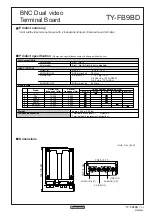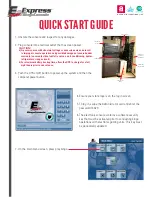
Section 7
Refrigeration System
7-9
BEFORE BEGINNING SERVICE
Ice machines may experience operational problems
only during certain times of the day or night. A
machine may function properly while it is being
serviced, but malfunctions later. Information
provided by the user can help the technician start in
the right direction, and may be a determining factor in
the final diagnosis.
Ask these questions before beginning service:
•
When does the ice machine malfunction? (night,
day, all the time, only during the freeze cycle,
etc.)
•
When do you notice low ice production? (one day
a week, every day, on weekends, etc.)
•
Can you describe exactly what the ice machine
seems to be doing?
•
Has anyone been working on the ice machine?
•
Is anything (such as boxes) usually stored near or
on the ice machine which could obstruct airflow
around the machine?
•
During “store shutdown,” is the circuit breaker,
water supply or air temperature altered?
•
Is there any reason why incoming water pressure
might rise or drop substantially?
ICE PRODUCTION CHECK
The amount of ice a machine produces directly relates
to the operating water and air temperatures. This
means an ice machine in a 70
°
F (21.2
°
C) room with
50
°
F (10.0
°
C) water produces more ice than the same
model ice machine in a 90
°
F (32.2
°
C) room with
70
°
F (21.2
°
C) water.
1.
Determine the ice machine operating conditions:
Air temp. entering condenser:
____
°
Air temp. around ice machine:
____
°
Water temp. entering float valve:
____
°
2.
Refer to the appropriate 24 Hour Ice Production
Chart. (These charts begin on page 7-31.) Use the
operating conditions determined in Step 1 to find
the published 24 ice production:
______
3.
Perform an actual ice production check. Use the
formula below.
1. ____ __________ =
__________
Freeze Time
Harvest Time
Total Cycle Time
2.
1440
÷÷÷÷
__________ =
__________
Minutes in 24 Hours
Total Cycle Time
Cycles Per Day
3. __________ x __________ =
__________
Weight of One Harvest
Cycles Per Day
Actual 24 Hour Ice Production
Important
•
Times are in minutes.
Example: 1 min., 15 sec. converts to 1.25 min.
(15 seconds
÷
60 seconds = .25 minutes)
•
Weights are in pounds.
Example: 2 lb., 6 oz. converts to 2.375 lb.
(6 oz.
÷
16 oz. = .375 lb.)
•
Weighing the ice is the only 100% accurate
check. However, if the ice pattern is normal and
the 1/8” thickness is maintained, the ice slab
weights listed with the 24 Hour Ice Production
Charts may be used.
4.
Compare the results of Step 3 with Step 2. Ice
production is normal when these numbers match
closely. If they do not match closely, determine if:
•
another ice machine is required.
•
more storage capacity is required.
•
relocating the existing equipment to lower the
load conditions is required.
Contact the local Manitowoc distributor for
information on available options and accessories.
Содержание J-1300
Страница 1: ...J Model Service Manual 1997 Manitowoc Ice Inc Part No 83 5631 9 Rev A 8 97 Ice Machines ...
Страница 10: ...Warranty Section 1 1 2 THIS PAGE INTENTIONALLY LEFT BLANK ...
Страница 14: ...Section 2 Installation References 2 4 deflector is compatible with Manitowoc ice machines ...
Страница 29: ...Section 2 Installation References 2 18 THIS PAGE INTENTIONALLY LEFT BLANK ...
Страница 45: ...Section 3 Maintenance 3 16 THIS PAGE INTENTIONALLY LEFT BLANK ...
Страница 105: ...Section 6 Electrical System 6 54 THIS PAGE INTENTIONALLY LEFT BLANK ...
Страница 148: ...Section 7 Refrigeration System 7 43 THIS PAGE INTENTIONALLY LEFT BLANK ...
Страница 164: ......
















































